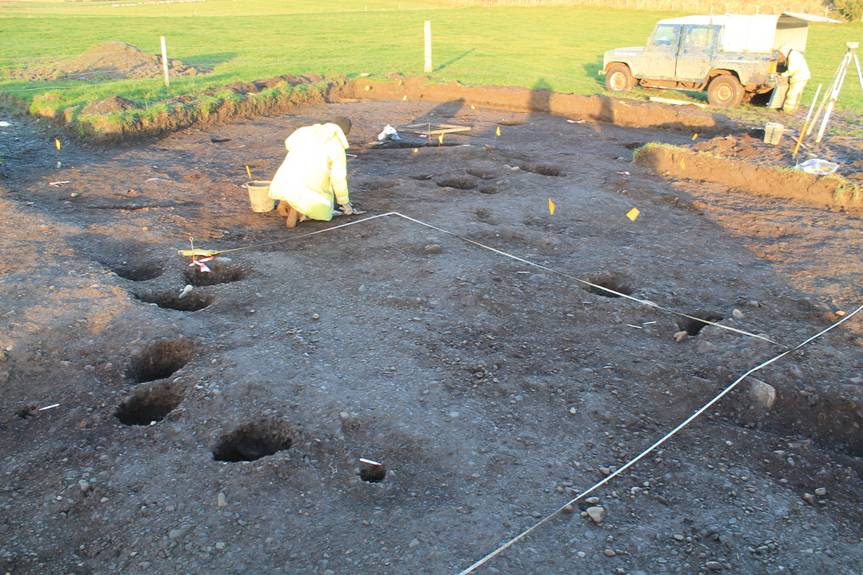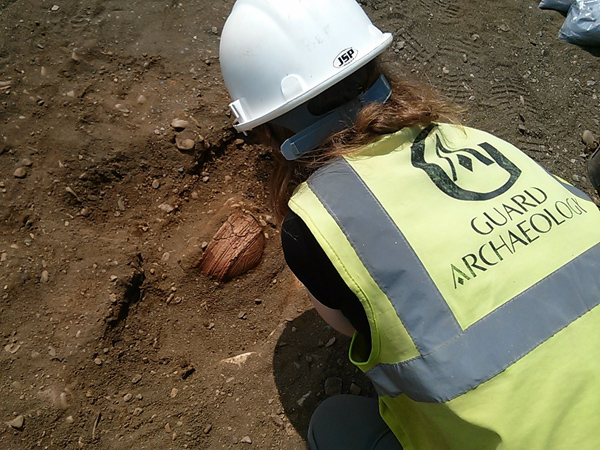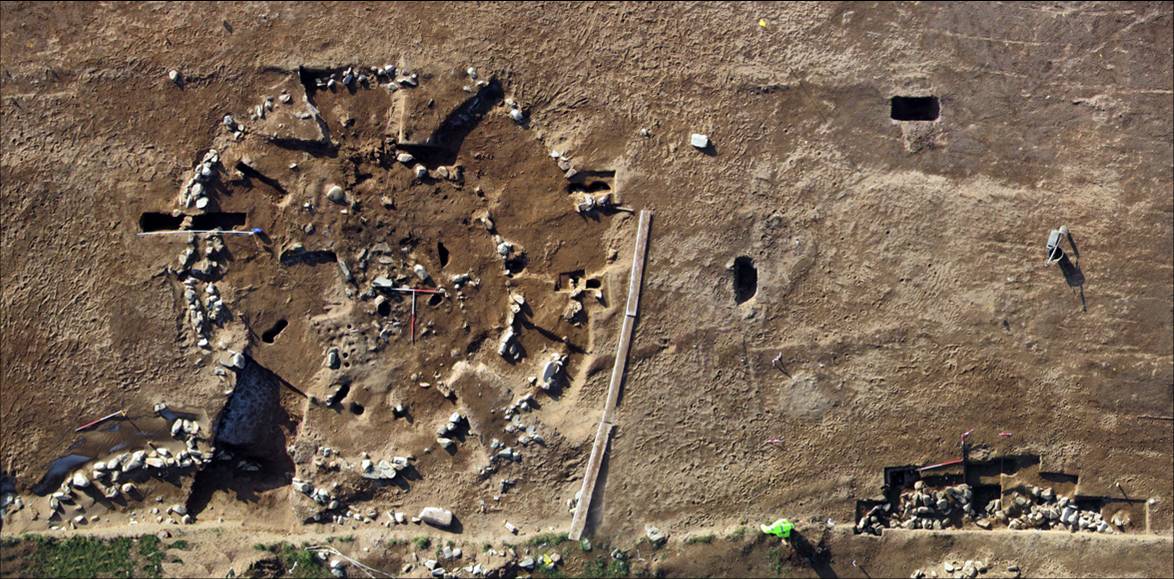Over the last couple of years, GUARD Archaeology teams led by GUARD Archaeologists Warren Bailie and Kevin Mooney, have undertaken excavations at Dunragit in Dumfries and Galloway, which have discovered a range of prehistoric archaeology including the earliest known house in south-west Scotland dating to the Mesolithic period, as well as a Neolithic structure, Neolithic/Early Bronze Age stone lined cists, a Bronze Age cemetery complex and an Iron Age village. The archaeological excavations were funded by Transport Scotland and undertaken in collaboration with Amey and RJ McLeod in advance of the A75 Dunragit Bypass.
The remains of a Mesolithic house was discovered in an area of criss-crossing palaeochannels, on the edge of a former estuary which existed here throughout prehistory. Radiocarbon dates recovered from the Mesolithic house revealed that this settlement dates to around 6000 BC. A perforated stone adze was found on the Mesolithic site, not a common find on sites of this period this may have been used to work wood. In excess of 13,500 Mesolithic flint microliths and knapping waste were recovered, indicating that this site represents a core focus of Mesolithic activity in this area of south-west Scotland. The location here, on a coastal fringe, was probably deliberately chosen by the occupants to exploit readily available resources of fish and shellfish seaward and hunting grounds close at hand in the hinterland.
Neolithic remains were also found, and which may be related to the nearby ceremonial complex at Dunragit, previously excavated by Manchester University between 1999 and 2002. This comprised three concentric rings of timber posts, which had been preceded by a post-defined cursus monument. These remains were first spotted through aerial photography and the only visible part of this ceremonial complex is Droughduil Mote, a prominent conical shaped mound to the south of Dunragit. This was once assumed to be a medieval motte but the Manchester University excavation revealed it to be a Neolithic mound, perhaps used as a elevated platform in Neolithic ceremonies, before an Early Bronze Age cairn was built on it summit.
The new bypass route was carefully selected to avoid this archaeology and other known archaeological cropmarks, most of which are scheduled monuments. However, amongst the new archaeological remains discovered during the removal of topsoil from the A75 Bypass route, were Neolithic remains perhaps associated with the ceremonial complex.
A Neolithic structure or house was found by the GUARD Archaeology team, constructed of multiple posts and from which amongst the flint and pottery artefacts was found a leaf-shaped flint arrowhead of Neolithic date. This rectilinear structure lay on a ridge overlooking the lower lying area of the Mesolithic site.
On this same ridge the GUARD Archaeology team also recovered two jet necklaces from two separate stone-lined pits or cists, as well as a beaker and food vessel. The jet necklaces are of exceptional quality, made from jet that originated from Yorkshire and are the first such jet necklaces to be found in south-west Scotland. The Beaker pottery dates to the end of the Neolithic/ beginning of the Bronze Age period and may be linked to the introduction of the Beaker Culture from Europe into south-west Scotland at that time.
No bone survived in either cist, but further post-excavation work is expected to include chemical tests to tell us whether the bodies were removed from their graves or if these were ritual deposits or cenotaphs. These cemeteries appear to have been used over the late third and second millennia BC.
Two Bronze Age cemeteries were also discovered. 20 cremations of likely Bronze Age date were excavated, including three Barrows. Finds from the excavations here included several fragmentary urns and one wholly intact example which contained the cremated remains of an adult. Flint artefacts were also recovered and one of particular interest was a very finely serrated transverse flint blade.
The remains of six Iron Age round-houses were also discovered. Known Iron Age settlements in Galloway tend to be enclosed by palisades or ramparts and found predominantly on hilltops, higher ground, coastal promontories or lochs, forming defended duns, hill forts, promontory forts or crannogs. Unenclosed settlements of the Iron Age tend to comprise single houses, but the Dunragit settlement is unusual in appearing to be a large unenclosed settlement on low-lying ground. It is only the second such Iron Age village to be found in Galloway, a previous one being discovered last year on the banks of the Black Loch of Myrton in the Machars. Iron Age pottery, which is not normally found on Iron Age settlements in Galloway was recovered from the Dunragit round-houses, as well as a Romano-British Iron Age brooch and evidence of metalworking. While radiocarbon dating has still to be undertaken, the artefacts indicate occupation of this settlement around two thousand years ago.
It is not certain if the Romans had a specific positive or negative influence on this community but the settlement appears to have been occupied during the Roman occupation in the early centuries AD and a Roman road passes close by.
GUARD Archaeology's post-excavation work on these finds is due to commence soon, but the wealth of finds recovered from Dunragit is likely to reveal new insights into prehistoric Scotland from the Mesolithic to the Iron Age eras, encompassing a range of ceremonial, burial and domestic structures and activities.





